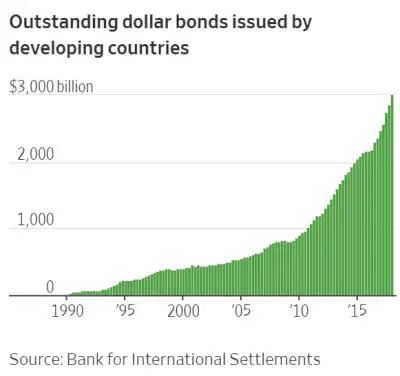Let’s start with Caterpillar, the maker of earth moving equipment that has for years been the poster child for global slowdown. Every quarter was worse than the last as mining and construction companies around the world cut back on orders. Here’s a typical 2015 headline from Zero Hedge: “If Caterpillar’s Data Is Right, This Is A Global Industrial Depression”.
Then it all changed. The report Cat issued today showed huge gains in earnings on far better than expected order flows. Everybody, it seems, is suddenly moving earth out there. As MSN trumpted this morning: “Caterpillar gives huge vote of confidence to global economy”.
US home prices, meanwhile are “surging.” In the most recent reporting month they were up 6.3% nationwide and are now 6.7% higher than their 2006 bubble peak. Seattle, Las Vegas and San Francisco are all seeing double-digit y-o-y gains.
Now for the big (and maybe bad) one:
Why the U.S. Bond Milestone Will Ripple Across Global Markets
(Wall Street Journal) – In globally connected markets, what U.S. consumers and businesses pay for their mortgages and loans can affect financial assets from Beijing to Buenos Aires.
The yield on the 10-year U.S. Treasury reached 3% Tuesday for the first time since the beginning of 2014, a long-awaited landmark in the move away from years of ultralow borrowing costs.
Asset prices, currencies and borrowing costs around the world are steered by movements in U.S. government bonds, considered by many investors to be the ultimate safe asset.
A shift in yields can hit dollar-denominated debt issued in emerging markets or the global currencies that move against the greenback as it reacts to higher yields. As rates rise in the U.S., global investors may be shifting cash to take advantage of higher returns, affecting trillions of dollars’ worth of assets in markets around the world.
The benchmark 10-year bond yield has climbed from a low of 1.36% in July 2016.
“Three percent in some ways is just a psychological level, but it does prompt investors to start to ask the question about who’s exposed to interest rate risk,” said Charles St-Arnaud, senior investment strategist at Lombard Odier IM.
“If the spillover effect of higher global yields spread to corporates or households you could see some pain there,” he added.Companies and governments that issue their debt in U.S. dollars, particularly in emerging markets, feel the squeeze when U.S. yields rise.
The amount of dollar bonds issued in developing countries has more than tripled to nearly $3 trillion since 2008 and the start of the financial crisis, according to Bank for International Settlements data.
Yields are rising as a rally in the oil price brings anticipation of higher inflation and expectations that global central banks will act to curb it. But U.S. yields have been gradually rising anyway, as the Federal Reserve raises rates.
Emerging market bonds typically suffer more when inflation is driving U.S. yields higher.
When yields rise on stronger growth prospects, the premium or spread to emerging market debt tends to shrink, according to Michael Biggs, macro strategist and investment manager at asset management firm GAM. But when Treasury yields rise because of inflationary pressure or other risk factors those in emerging markets generally rise in tandem or move higher.
“We’re not worried when U.S. yields go up on the back of stronger growth, but on the back of stronger inflation, that’s a whole different story,” Mr. Biggs said.
Financial crises frequently start at the periphery (subprime mortgages in 2007, for instance) and then start toppling dominoes on the way to the center. That’s why spiking yields for emerging market debt scare so many analysts. If countries that had been buying lots of stuff from the rest of the world with borrowed money lose the ability to borrow more, then global growth takes a hit. AND all the banks and hedge funds that have lent money to these guys or written derivatives on their bonds are in potentially big trouble.
In today’s world of New Age finance, as goes the leveraged speculating community, so goes everything else.



2 thoughts on "Getting Tight! Not Just Here But Everywhere"
crash now